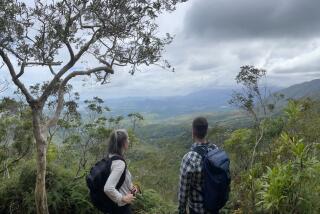Full Sequence of Fly’s Genes Deciphered
- Share via
Heralding a new era in the effort to understand heredity, researchers today published the full genetic sequence of the most important laboratory tool for deciphering the book of life: the tiny fruit fly.
For a century, the humble creature, called drosophila, has been the subject of sustained scrutiny by scientists seeking to understand the unity of life. In the constricted genetic alphabet of the fly, researchers have discovered master keys to physical development and aging. In other fly genes--with names like timeless, dissatisfaction and bizarre--they found glimmers of the anatomy of instinct and behavior.
By analyzing the complete biochemical text of the drosophila genetic code, scientists at UC Berkeley, Baylor and other universities working with the Maryland company Celera Genomics have achieved a milestone that is a prelude to the completion of the human genome later this year, several experts said.
“This is a remarkable achievement . . . because of the fruit fly’s pivotal role in research, ranging from aging and cancer to learning and memory,” said Dr. Francis Collins, director of the National Human Genome Research Institute, which funded some of the work.
Barely the size of a punctuation mark, the fruit fly is the largest and most complex animal yet whose genetic code has been deciphered. It is also the first organism with a central nervous system to be sequenced.
The normal fruit fly has six legs, red eyes and five chromosomes containing 125 million chemical “base pairs,” which are the interlocking building blocks of genes. For decades, scientists have used this little gadfly as a living test tube, deliberately breeding mutant flies to see how genetic variations affect development and behavior.
Among the 13,600 genes that make up the instruction set for a fly, the researchers identified hundreds apparently shared by almost all complex life forms, including human beings, and also discovered hundreds of new genes.
“To an extent that nobody anticipated or imagined, the mechanisms in the fly are relevant to the same processes in humans,” said geneticist Thomas Kornberg at UC San Francisco, who called the drosophila genetic sequence a “Rosetta stone” for the human genome.
At the same time, the sequencing vindicated a controversial new technology that is central to the effort to analyze the estimated 140,000 genes of humankind. The technique, called shotgun sequencing, can read the complete biochemical text of gene sequences much faster than anyone would have guessed when the human genome project was first proposed more than a decade ago.
The success of the sequencing effort owed as much to advanced computing techniques as to molecular biology.
With the shotgun technique, the chemical genome is broken quickly into myriad tiny random fragments, sorted and then reassembled, using proprietary computer formulas running on one of the world’s largest supercomputing facilities.
To properly assemble the fly genome, researchers had to electronically juggle about 1.76 billion items of genetic data to correctly line up the 3.2 million sequence fragments. The task required 16 advanced computer processors, many gigabytes of memory, and about 250,000 lines of customized computer code.
“Think of trying to do a 3.2-million-piece jigsaw puzzle,” said Gene Myers, Celera’s vice president of informatics research, who spearheaded the computer effort. “It is a daunting computation, and the human genome is 30 times that big.”
Using the same technique, researchers were able to sequence about 1.2 billion chemical letters in the human genome in just five weeks, Celera reported late last year. Company executives say they have since sequenced almost 90% of the human genome and a rough draft of the entire genome may be available later this spring.
Scientists so far have determined the complete biochemical sequence of just one of the 23 human chromosomes, although researchers in recent years have identified many individual human genes. The first chromosome to be finished was sequenced by the federal genome research institute, coordinated by the National Institutes of Health.
Although the drosophila project was a joint effort of public and private gene researchers, the collaborators have fallen out in bitter disputes about who should own the human genome data and how much of it should be freely available.
The stakes are high, because an understanding of human genes is expected to revolutionize medicine and the treatment of disease and to offer humanity unprecedented power to alter its own inheritance.
Worried that private companies may seek monopoly rights over basic genetic information, Bruce Alberts, president of the U.S. National Academy of Sciences, and Sir Aaron Klug, president of the Royal Society of London, issued a joint statement Thursday saying that “the human genome itself must be freely available to all mankind.”
The drosophila genome made public in today’s issue of the journal Science “is so exciting because it is a prelude to having the human genome figured out,” said Caltech Nobel laureate Edward Lewis, who studies fruit fly genetics.
Indeed, scientists have been surprised at how much of what they have discovered in the genes of the fruit fly is duplicated in human beings.
When researchers at Berkeley and Celera compared drosophila’s genes to 289 known human-disease genes, they found that the fly shares 177 of them, covering a wide range of diseases.
“The fact that the majority of genes known to cause human disease have well-conserved counterparts in the fly argues that the information uncovered in drosophila will have direct relevance to human health,” said Gerald M. Rubin at UC Berkeley, who was a senior scientist in the sequencing effort.
Richard G. Walker and his colleagues at UC San Diego, for example, today announced they have discovered a drosophila gene that, when altered, leaves flies unable to sense and hear the world around them. The researchers said the mutant gene was a molecular clue to how humans and other complex organisms hear and maintain their balance and sense of touch.
Earlier this week, researchers at Brigham and Women’s Hospital and Harvard Medical School in Boston said they had created fruit flies with symptoms of Parkinson’s disease, which they hope to use to study the fatal and incurable brain disease.
“In essence,” said UC San Diego biologist Charles S. Zukor, “we are nothing but a big fly.”






